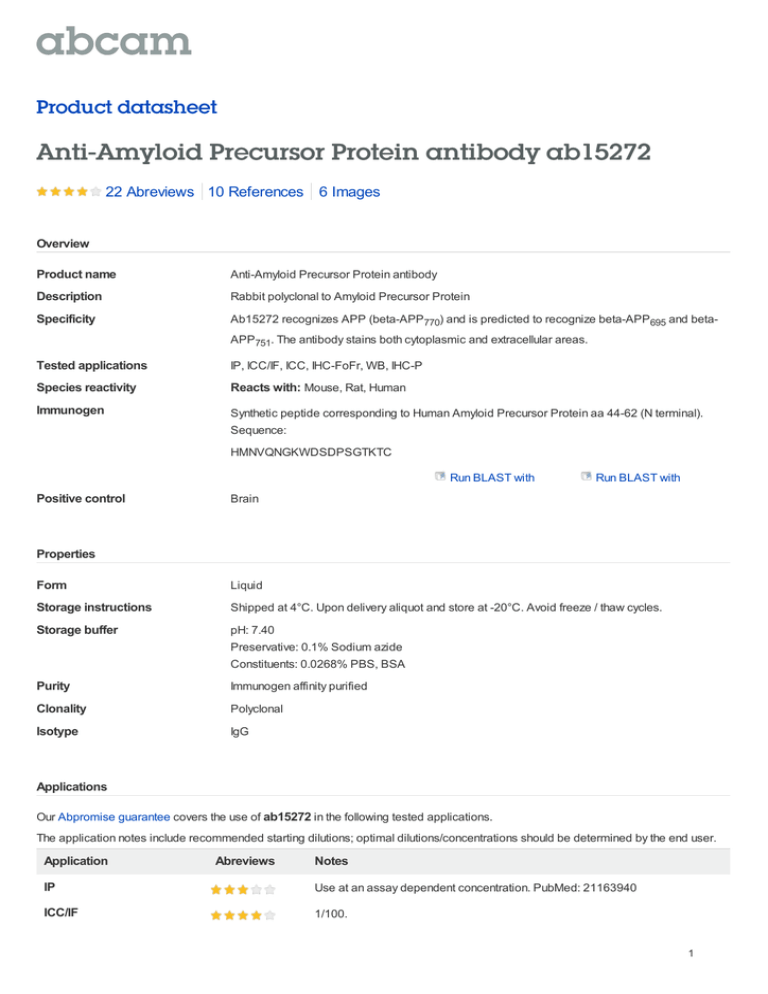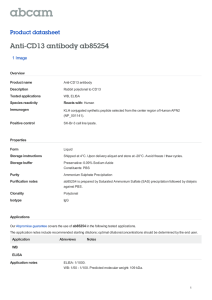Anti-Amyloid Precursor Protein antibody ab15272 Product datasheet 22 Abreviews 6 Images
advertisement

Product datasheet Anti-Amyloid Precursor Protein antibody ab15272 22 Abreviews 10 References 6 Images Overview Product name Anti-Amyloid Precursor Protein antibody Description Rabbit polyclonal to Amyloid Precursor Protein Specificity Ab15272 recognizes APP (beta-APP770) and is predicted to recognize beta-APP695 and betaAPP751. The antibody stains both cytoplasmic and extracellular areas. Tested applications IP, ICC/IF, ICC, IHC-FoFr, WB, IHC-P Species reactivity Reacts with: Mouse, Rat, Human Immunogen Synthetic peptide corresponding to Human Amyloid Precursor Protein aa 44-62 (N terminal). Sequence: HMNVQNGKWDSDPSGTKTC Run BLAST with Positive control Run BLAST with Brain Properties Form Liquid Storage instructions Shipped at 4°C. Upon delivery aliquot and store at -20°C. Avoid freeze / thaw cycles. Storage buffer pH: 7.40 Preservative: 0.1% Sodium azide Constituents: 0.0268% PBS, BSA Purity Immunogen affinity purified Clonality Polyclonal Isotype IgG Applications Our Abpromise guarantee covers the use of ab15272 in the following tested applications. The application notes include recommended starting dilutions; optimal dilutions/concentrations should be determined by the end user. Application Abreviews Notes IP Use at an assay dependent concentration. PubMed: 21163940 ICC/IF 1/100. 1 Application Abreviews Notes ICC Use at an assay dependent concentration. IHC-FoFr 1/100. WB Use a concentration of 1 µg/ml. Predicted molecular weight: 87 kDa. ab15272 reacts strongly with some immature isoforms and cleavage products (Range 3070 kDa). Weaker signal from mature isoforms (over 100 kDa) (this maybe due to steric inhibition by post-translational modifications). IHC-P 1/100. Target Function Functions as a cell surface receptor and performs physiological functions on the surface of neurons relevant to neurite growth, neuronal adhesion and axonogenesis. Involved in cell mobility and transcription regulation through protein-protein interactions. Can promote transcription activation through binding to APBB1-KAT5 and inhibits Notch signaling through interaction with Numb. Couples to apoptosis-inducing pathways such as those mediated by G(O) and JIP. Inhibits G(o) alpha ATPase activity (By similarity). Acts as a kinesin I membrane receptor, mediating the axonal transport of beta-secretase and presenilin 1. Involved in copper homeostasis/oxidative stress through copper ion reduction. In vitro, copper-metallated APP induces neuronal death directly or is potentiated through Cu(2+)-mediated low-density lipoprotein oxidation. Can regulate neurite outgrowth through binding to components of the extracellular matrix such as heparin and collagen I and IV. The splice isoforms that contain the BPTI domain possess protease inhibitor activity. Induces a AGER-dependent pathway that involves activation of p38 MAPK, resulting in internalization of amyloid-beta peptide and leading to mitochondrial dysfunction in cultured cortical neurons. Provides Cu(2+) ions for GPC1 which are required for release of nitric oxide (NO) and subsequent degradation of the heparan sulfate chains on GPC1. Beta-amyloid peptides are lipophilic metal chelators with metal-reducing activity. Bind transient metals such as copper, zinc and iron. In vitro, can reduce Cu(2+) and Fe(3+) to Cu(+) and Fe(2+), respectively. Beta-amyloid 42 is a more effective reductant than beta-amyloid 40. Betaamyloid peptides bind to lipoproteins and apolipoproteins E and J in the CSF and to HDL particles in plasma, inhibiting metal-catalyzed oxidation of lipoproteins. Beta-APP42 may activate mononuclear phagocytes in the brain and elicit inflammatory responses. Promotes both tau aggregation and TPK II-mediated phosphorylation. Interaction with overexpressed HADH2 leads to oxidative stress and neurotoxicity. Also binds GPC1 in lipid rafts. Appicans elicit adhesion of neural cells to the extracellular matrix and may regulate neurite outgrowth in the brain. The gamma-CTF peptides as well as the caspase-cleaved peptides, including C31, are potent enhancers of neuronal apoptosis. N-APP binds TNFRSF21 triggering caspase activation and degeneration of both neuronal cell bodies (via caspase-3) and axons (via caspase-6). Tissue specificity Expressed in all fetal tissues examined with highest levels in brain, kidney, heart and spleen. Weak expression in liver. In adult brain, highest expression found in the frontal lobe of the cortex and in the anterior perisylvian cortex-opercular gyri. Moderate expression in the cerebellar cortex, the posterior perisylvian cortex-opercular gyri and the temporal associated cortex. Weak expression found in the striate, extra-striate and motor cortices. Expressed in cerebrospinal fluid, and plasma. Isoform APP695 is the predominant form in neuronal tissue, isoform APP751 and isoform APP770 are widely expressed in non-neuronal cells. Isoform APP751 is the most abundant form in T-lymphocytes. Appican is expressed in astrocytes. 2 Involvement in disease Alzheimer disease 1 Cerebral amyloid angiopathy, APP-related Sequence similarities Belongs to the APP family. Contains 1 BPTI/Kunitz inhibitor domain. Domain The basolateral sorting signal (BaSS) is required for sorting of membrane proteins to the basolateral surface of epithelial cells. The NPXY sequence motif found in many tyrosine-phosphorylated proteins is required for the specific binding of the PID domain. However, additional amino acids either N- or C-terminal to the NPXY motif are often required for complete interaction. The PID domain-containing proteins which bind APP require the YENPTY motif for full interaction. These interactions are independent of phosphorylation on the terminal tyrosine residue. The NPXY site is also involved in clathrinmediated endocytosis. Post-translational modifications Proteolytically processed under normal cellular conditions. Cleavage either by alpha-secretase, beta-secretase or theta-secretase leads to generation and extracellular release of soluble APP peptides, S-APP-alpha and S-APP-beta, and the retention of corresponding membraneanchored C-terminal fragments, C80, C83 and C99. Subsequent processing of C80 and C83 by gamma-secretase yields P3 peptides. This is the major secretory pathway and is nonamyloidogenic. Alternatively, presenilin/nicastrin-mediated gamma-secretase processing of C99 releases the amyloid beta proteins, amyloid-beta 40 (Abeta40) and amyloid-beta 42 (Abeta42), major components of amyloid plaques, and the cytotoxic C-terminal fragments, gamma-CTF(50), gamma-CTF(57) and gamma-CTF(59). Many other minor beta-amyloid peptides, beta-amyloid 1-X peptides, are found in cerebral spinal fluid (CSF) including the betaamyloid X-15 peptides, produced from the cleavage by alpha-secretase and all terminatiing at Gln-686. Proteolytically cleaved by caspases during neuronal apoptosis. Cleavage at Asp-739 by either caspase-6, -8 or -9 results in the production of the neurotoxic C31 peptide and the increased production of beta-amyloid peptides. N- and O-glycosylated. O-glycosylation on Ser and Thr residues with core 1 or possibly core 8 glycans. Partial tyrosine glycosylation (Tyr-681) is found on some minor, short beta-amyloid peptides (beta-amyloid 1-15, 1-16, 1-17, 1-18, 1-19 and 1-20) but not found on beta-amyloid 38, beta-amyloid 40 nor on beta-amyloid 42. Modification on a tyrosine is unusual and is more prevelant in AD patients. Glycans had Neu5AcHex(Neu5Ac)HexNAc-O-Tyr, Neu5AcNeu5AcHex(Neu5Ac)HexNAc-O-Tyr and O-AcNeu5AcNeu5AcHex(Neu5Ac)HexNAc-OTyr structures, where O-Ac is O-acetylation of Neu5Ac. Neu5AcNeu5Ac is most likely Neu5Ac 2,8Neu5Ac linked. O-glycosylations in the vicinity of the cleavage sites may influence the proteolytic processing. Appicans are L-APP isoforms with O-linked chondroitin sulfate. Phosphorylation in the C-terminal on tyrosine, threonine and serine residues is neuron-specific. Phosphorylation can affect APP processing, neuronal differentiation and interaction with other proteins. Phosphorylated on Thr-743 in neuronal cells by Cdc5 kinase and Mapk10, in dividing cells by Cdc2 kinase in a cell-cycle dependent manner with maximal levels at the G2/M phase and, in vitro, by GSK-3-beta. The Thr-743 phosphorylated form causes a conformational change which reduces binding of Fe65 family members. Phosphorylation on Tyr-757 is required for SHC binding. Phosphorylated in the extracellular domain by casein kinases on both soluble and membrane-bound APP. This phosphorylation is inhibited by heparin. Extracellular binding and reduction of copper, results in a corresponding oxidation of Cys-144 and Cys-158, and the formation of a disulfide bond. In vitro, the APP-Cu(+) complex in the presence of hydrogen peroxide results in an increased production of beta-amyloid-containing peptides. Trophic-factor deprivation triggers the cleavage of surface APP by beta-secretase to release sAPP-beta which is further cleaved to release an N-terminal fragment of APP (N-APP). Beta-amyloid peptides are degraded by IDE. Cellular localization Membrane. Membrane, clathrin-coated pit. Cell surface protein that rapidly becomes internalized via clathrin-coated pits. During maturation, the immature APP (N-glycosylated in the endoplasmic reticulum) moves to the Golgi complex where complete maturation occurs (O3 glycosylated and sulfated). After alpha-secretase cleavage, soluble APP is released into the extracellular space and the C-terminal is internalized to endosomes and lysosomes. Some APP accumulates in secretory transport vesicles leaving the late Golgi compartment and returns to the cell surface. Gamma-CTF(59) peptide is located to both the cytoplasm and nuclei of neurons. It can be translocated to the nucleus through association with APBB1 (Fe65). Beta-APP42 associates with FRPL1 at the cell surface and the complex is then rapidly internalized. APP sorts to the basolateral surface in epithelial cells. During neuronal differentiation, the Thr-743 phosphorylated form is located mainly in growth cones, moderately in neurites and sparingly in the cell body. Casein kinase phosphorylation can occur either at the cell surface or within a postGolgi compartment. Associates with GPC1 in perinuclear compartments. Colocalizes with SORL1 in a vesicular pattern in cytoplasm and perinuclear regions. Anti-Amyloid Precursor Protein antibody images ab15272 at a 1/100 dilution staining Amyloid Precursor protein from human HEK cells by Immunocytochemistry. The antibody was incubated with the cells for 12 hours and then detected using a goat anti-rabbit IgG AlexaFluor ® 568. The image is courtesy of an Abreview submitted by Randal Moldrich on 25 January 2006. Immunocytochemistry/ Immunofluorescence Amyloid Precursor Protein antibody (ab15272) ab15272 at a 1/100 dilution staining Amyloid Precursor Protein from Rat Cells (Hippocampal neuron culture) by Immunocytochemistry. The antibody was incubated with the cells for 12 hours and then detected using a goat anti-rabbit IgG AlexaFluor® 568. The image is courtesy of an Abreview submitted by Randal Moldrich on 25 January Immunocytochemistry/ Immunofluorescence - 2006. Amyloid Precursor Protein antibody (ab15272) 4 Immunohistochemistry (Formalin/PFA-fixed Immunohistochemistry (Formalin/PFA-fixed paraffin-embedded sections) analysis of paraffin-embedded sections) - Anti-Amyloid human Alzheimers brain tissue labelling Precursor Protein antibody (ab15272) Amylois Precursor Protein with ab15272. ab15272 staining Amyloid Precursor Protein in 15 month old TASTPM mouse brain tissue section by Immunohistochemistry (Formalin/ PFA fixed paraffin-embedded sections). Tissue underwent fixation in formaldehyde, heat mediated antigen retrieval in 10mM citric acid buffer (pH 6.0) and blocking in 1% BSA for 10 minutes at 25°C. Immunohistochemistry (Formalin/PFA-fixed paraffin-embedded sections) - Amyloid Precursor Protein antibody (ab15272) This image is courtesy of an Abreview submitted by Mr Carl Hobbs The primary antibody was used at 1/300 dilution, and incubated with sample for 2 hours. A Biotin conjugated goat polyclonal to rabbit IgG at 1/200 dilution, was used as secondary. ab15272 staining Amyloid Precursor Protein in murine N2a cells by ICC (Immunocytochemistry). Cells were fixed with paraformaldehyde and blocked with 10% serum for 15 minutes at Immunocytochemistry - Anti-Amyloid Precursor 24°C. Samples were incubated with primary Protein antibody (ab15272) antibody (1/100 in 1% PBS) for 2 hours at This image is courtesy of an anonymous Abreview 24°C. An biotin-conjugated goat anti-rabbit polyclonal IgG (1/200) was used as the secondary antibody. 5 All lanes : Anti-Amyloid Precursor Protein antibody (ab15272) at 1/1000 dilution Lane 1 : Rat brain tissue lysate Lane 2 : Rat brain tissue lysate Lysates/proteins at 100 µg per lane. Secondary HRP-conjugated Goat anti-rabbit IgG polyclonal at 1/2000 dilution Western blot - Anti-Amyloid Precursor Protein developed using the ECL technique antibody (ab15272) This image is courtesy of an anonymous Abreview Performed under reducing conditions. Predicted band size : 87 kDa Observed band size : 87 kDa Exposure time : 30 seconds This image is courtesy of an anonymous Abreview Please note: All products are "FOR RESEARCH USE ONLY AND ARE NOT INTENDED FOR DIAGNOSTIC OR THERAPEUTIC USE" Our Abpromise to you: Quality guaranteed and expert technical support Replacement or refund for products not performing as stated on the datasheet Valid for 12 months from date of delivery Response to your inquiry within 24 hours We provide support in Chinese, English, French, German, Japanese and Spanish Extensive multi-media technical resources to help you We investigate all quality concerns to ensure our products perform to the highest standards If the product does not perform as described on this datasheet, we will offer a refund or replacement. For full details of the Abpromise, please visit http://www.abcam.com/abpromise or contact our technical team. Terms and conditions Guarantee only valid for products bought direct from Abcam or one of our authorized distributors 6
![Anti-Myeloid Precursor Cells antibody [ER-MP58] ab63860](http://s2.studylib.net/store/data/012462166_1-e5886b0a92755c9046e4cae18d1d42da-300x300.png)


